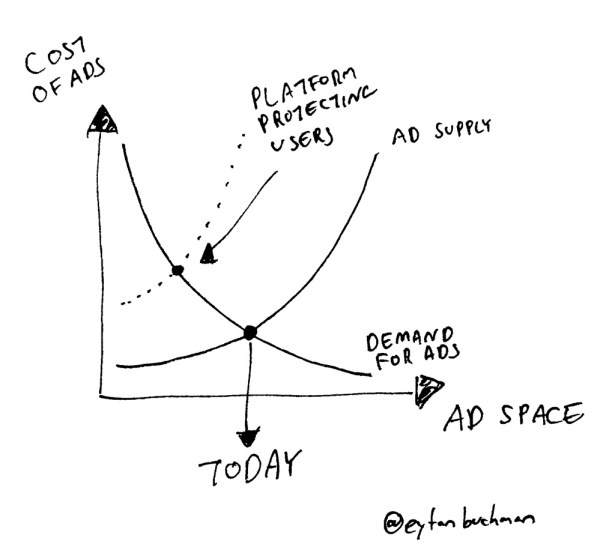Life for Marketers Is About To Get Harder. Here’s Why.
tldr
It’s harder to earn attention today. That’s getting hard with platforms guarding their audiences, less physical screen space, and the switch to voice/AR. Like always, it’s more important than ever to drive value with content to stick out.Life is hard for digital marketers
Like everyone, I’m overwhelmed by the amount of information online.
I’m not talking only ads. There are dozens of newsletters and hundreds of sites I want to read but can’t. The bar to infiltrate daily workflows is really, really high. Getting into my routine is a zero-sum game that comes at the expense of something else.
Let’s call a spade a spade - **this sucks for marketers&&.
Information proliferation has made getting qualified attention a Herculean test for digital marketers. Why?
Because it’s hard to buy attention.
Paid attention is getting more expensive with diminishing returns. eCPM costs at the Super Bowl soared 9X, from $19 in 1990 to $163 in 2013. In 2016, for the first time ever, US digital ad spend exceeded TV ad spend.
But CPC costs are growing too. In a digital advertising arms race, more impressions are leading to diminishing returns. Spend more, get less.
And it’s hard to earn attention
Earned attention requires sticking out in a saturated environment, a fact that ushered in the Clickbait Generation. Even with stellar content, limited attention means it’s hard to break out. Take aggregators. Mattermark, Launch Ticker and Term Sheet are all incredible…but even pure gold, 100% free newsletters don’t get read everyday. So how can other content compete?
Why is digital marketing so hard today?
- We compete with great content. The limited time that people do have, they spend on channels they already like. Discovery takes effort.
- We compete with crappy content. Click-bait content proliferation means display ad saturation dynamics in the content arena. As a result, it’s harder to be found even when people are in discovery mode.
- Creating is hard. Great content requires time, money and creativity. And if you’re creating top-of-funnel content, costs accrue further for down-funnel content.
- Even great distribution isn’t foolproof. Snapchat may have made it big from the New York Times sexting article but many startups can attest to a TechCrunch article that didn’t deliver. I know I can.
- Promotional Blindness – Display ads (can) suck. Look at media kits. A 0.08% CTR isn’t particularly rare. For every 1,200 readers, ONE person might click. Probably by mistake.

A Techcrunch publication does not solve everything.
Why It’s Going To Get Harder
Advertisement inventory on platforms will shrink
Platform operators guard their domains ferociously, providing exposure by their own rules. If they don’t put up barriers, they die ( cough Twitter ). Sites that police better, like Facebook, survive. So the barriers go up to:
- Ensure ads are relevant, penalizing poor quality with higher costs (or not letting them on the platform in the first place).
- Reduce ad real estate to balance a good user experience with maximum profitability. Likely one reason why Google cut the number of ads in search results from 6 to 4 in 2016.
Ad space and cost is a classic supply/demand matrix. When platforms artificially limit ad space for improved user experience, ad costs rise. In September 2016, Facebook sold out its entire ad inventory, likely signaling that its barriers will start to go higher.

More ad space!
There’s less physical screen space
Cellphone and laptop screens have limited real-estate. Even iPhone screens, which were steadily growing, have plateaued. On a software level, operating systems like iOS and Android create very specific style guides to encourage drawing within the lines. Violators exist but large platforms rely on Darwinian app evolution to weed out violators of invasive design.
Marketers evolve, shifting from webpages to bookmarks and then to extensions. Then they look for new places, like the menu bar (ala Cortana’s invasive updates) and notifications. And when new screen real-estate opens, (like new tab windows apps) marketers jump. Sure enough, this creates another zero-sum race to the top of the hill.
Augmented reality and audio interfaces
Screens are so 2016. Augmented reality and audio interfaces both aim to reduce sensory input, offering relevant and contextual information.
But they both have the potential to be incredibly invasive; they’re literally everywhere. Amazon worked hard to get Alexa in over 5 million homes and will not give in to low-quality content. The platform will remain king, ad and content filtering will remain kingmaker and there will always be advertisers willing to spend more money to play by the rules, pricing out cheaper access.
This is true for earned exposure as well. To make it into people’s ears or virtual realities, only the best of the best will make it past reader’s filters and the platform filters.
What it means
Together, this paints a picture of higher barriers for marketers:
- Platforms will continue to reduce ad space
- There’s less physical space for ads
- New mediums will have less tolerance for generic, low-quality content.
Great product/market fit, hyper-targeted marketing and exceptional understanding of target audiences was key for digital marketing until now. With limited attention and space, it’s only getting more important.